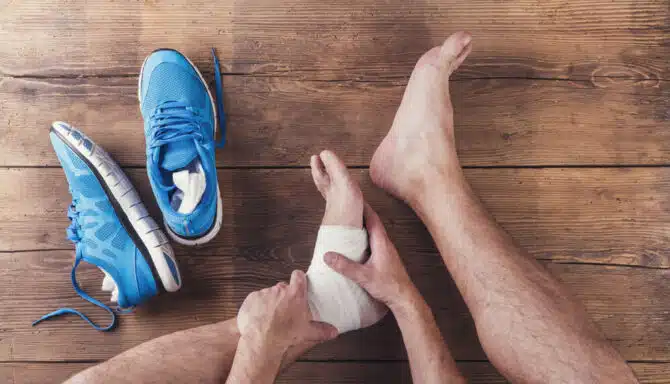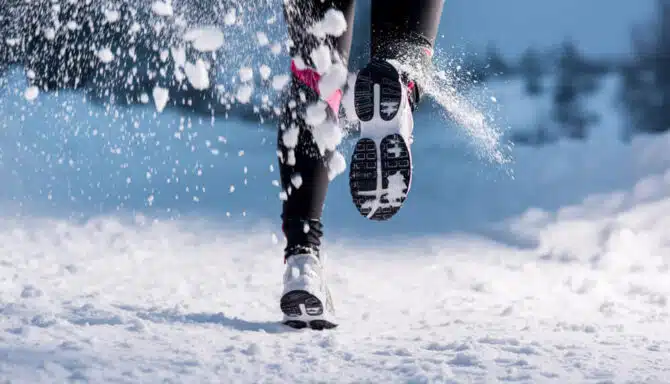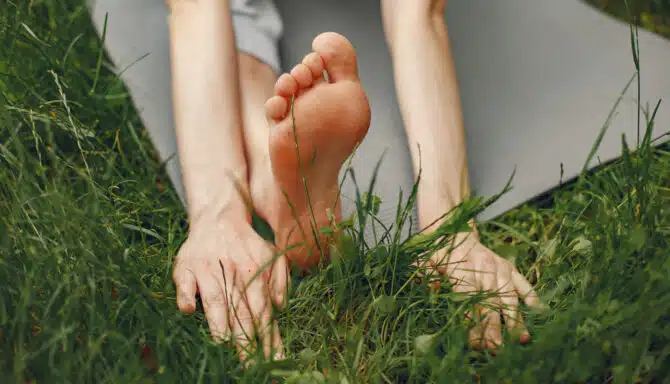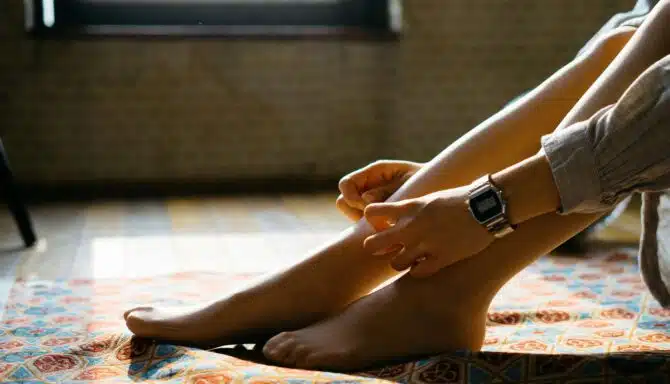November 14, 2024
Foot injuries can increase in cold weather, so it’s important to learn how to minimize your risk, practice fall prevention, and navigate slippery conditions. Not only that, but cold weather can cause muscle stiffness to worsen, making your feet more vulnerable than they were during the warmer months. Today we’ll talk about 3 safety tips—recommended by the foot specialists at our Toronto foot clinic—to prevent winter foot injuries.
3 Tips to Prevent Winter Foot Injuries
Wear The Right Shoes
Try Warm Ups and Foot Exercises
Wear Supportive Insoles
1. Wear The Right Shoes
The wrong winter boots can lead to numerous foot injuries. While fashion may be your top priority, you shouldn’t sacrifice protective and supportive features just for looks (plus, you can find fashionable and comfortable shoes at our Toronto foot clinic). Winter footwear should have good shock absorption and be made with waterproof materials. Avoid pointed toes and high heels in the winter—these features are a recipe for slips and falls!
https://youtube.com/shorts/R7GV0GbKhvQ?si=NhfPArwoRH1Vnt1q
Stability And Motion Control Shoes
Did you know there are different foot types, and your foot type can determine what shoes you should wear? For example, people with flat feet need extra stability or motion control features built into their shoes to help correct varying degrees of overpronation (when the ankle rolls inward during movement). A foot specialist, like a podiatrist or chiropodist, can assess your feet and tell you what type shoes you should be wearing:
Stability Shoes
Purpose: Stability shoes are aimed at those with mild to moderate overpronation (the inward rolling of the foot when walking or running).
Features: These shoes typically have a supportive structure and posting around the arch and midsole to help guide the foot through a natural gait cycle and promote natural foot motion.
Motion Control Shoes
Purpose: These are designed for people with severe overpronation, providing maximum support to prevent excessive inward rolling of the foot.
Features: Motion control shoes are more rigid and structured than stability shoes, with reinforced areas in the midsole.
How does this link back to winter foot safety? If you have flat feet, especially if you’re a senior, and your feet overpronate, your hips, knees and ankles can weaken and become more painful and vulnerable due to years of walking with an abnormal gait. If you don’t have strong feet and joints, icy conditions become that much more threatening.
Both stability and motion control shoes can help prevent winter foot injuries by providing extra support and control in conditions where icy, wet, or uneven surfaces make slips and strains more likely. Keep in mind these should also have solid traction performance!
https://youtube.com/shorts/AfuPpZv2LP4?si=WV3KZ4alGqWZLlyP
Traction Performance
High traction performance in shoes (thick, rubber soles with grooves) is essential for winter injury prevention. It prevents slips and falls, which are especially common on icy or wet surfaces. Without reliable traction, even the smallest patch of ice can turn into a serious hazard, causing the foot to slide out from under the body and throwing balance off entirely. This can lead to falls, which are a primary cause of winter injuries, including sprains, fractures, and ligament tears in the foot, ankle, or knee.
Good traction provides a stable, controlled grip on unpredictable surfaces, allowing each step to connect firmly with the ground. This stability reduces the risk of unexpected slips and ensures that the foot can maintain contact without sliding, even on slippery patches. People who enjoy running during the winter months should particularly focus on finding running shoes with traction. Many brands, like Saucony or ASICS, design shoes for this purpose. You can also add on ice cleats or cramp-ons to your footwear for extra grip when running on icy surfaces.
When looking for traction performance, keep in mind that no shoes are built for traction on ice (although some may fare better than others). Only ice cleats or cramp-ons will provide proper grip on ice.
2. Try Warm-ups And Foot Exercises
Before going for a run, warm up your feet and lower extremities with a nice, healthy stretch or foot exercise. This will prepare your feet for pounding the pavement (or snow) and give them an added layer of strength and protection. Runners should be doing this year round as part of their foot care routine, not just during the winter!
These routines are not just for runners! Quite the opposite, in fact; they help people with mobility constraints and inflamed, weakened and damaged muscles/joints just as much as they do athletes.
People with arthritis in the feet, plantar fasciitis and other conditions can help reduce their risk of winter injuries by strengthening their feet. For example, arthritis can lead to joint pain, stiffness, and reduced range of motion, making it challenging to maintain balance on slippery or uneven surfaces. On the other hand, plantar fasciitis involves inflammation of the plantar fascia, the ligament that runs along the bottom of the foot. The discomfort may lead to altered walking mechanics, such as favoring one foot over the other, which can compromise stability and increase the risk of falls.
Stretches and exercises should target the intrinsic (small, stabilizing muscles located within the foot) and extensor muscles (primarily found in the lower leg), and your ankles. Your routine should include a variety of movements that target as many muscle groups as possible.
Here are a few easy, effective stretches and exercises you can start today:
https://www.youtube.com/shorts/gOwgyrmU6hM
Toe Splays: While seated or standing, spread (or "splay") your toes as wide apart as possible, holding for a few seconds, then releasing. Repeat this 10–15 times per foot.
Toe Flex and Raise: Stand with toes planted and lift the heels off the ground. This exercise strengthens the lower leg and foot muscles, improving balance and stability on icy surfaces.
Ankle Circles: Sit or stand and slowly rotate each ankle in circles, first clockwise and then counterclockwise. This helps increase ankle mobility and flexibility, which can reduce the risk of sprains.
Seated Hamstring Stretch: Sit on a chair, extend one leg straight in front. Lean forward slowly until you feel the stretch in your hamstring. Hold for about 30 seconds.
In addition, click here for part 1 and part 2 for the best exercises for arthritis, and here for the best exercises for plantar fasciitis.
https://www.youtube.com/shorts/AsuUXJYnUmQ
The Importance of Balance
We all know the direct link between losing your balance and sustaining an injury. We also know that people with disabilities or conditions that impact mobility need to be extra vigilant. With every step, strong balance allows you to react as quickly as possible to unexpected changes in winter terrain and surfaces, which will keep you safe.
Here are two simple foot exercises that focus on improving balance:
Single-Leg Stands: Stand on one foot for 20–30 seconds, then switch. This exercise builds balance and strengthens the muscles around the ankle, reducing the risk of falls on uneven surfaces.
Heel-to-Toe Walk: Walk in a straight line, placing the heel of one foot directly in front of the toes of the other. This exercise improves balance and strengthens stabilizing muscles.
3. Wear Supportive Insoles
Winter footwear is typically built for the elements - not for comfort. Therefore, it can be very difficult to find a supportive winter boot that will also protect your feet from winter weather. Fortunately, if you wear a supportive insole with your footwear, you won't need to sacrifice comfort for function. There are two types of supportive insoles you can wear with winter footwear: customer orthotics and over-the-counter insoles.
Custom Orthotics
Custom orthotics are designed to fit the unique contours of an individual's feet, helping to redistribute pressure and provide the necessary arch support. This is especially beneficial for individuals with flat feet or other conditions. Add winter to the mix, and this becomes even more crucial. By optimizing foot alignment, custom orthotics help maintain stability and balance, allowing individuals to navigate slippery surfaces with greater confidence.
Custom orthotics can be made to fit in winter boots or winter running shoes, to keep your foot supported in all scenarios. They can even come in half-lengths to accommodate dress shoes for when you’re leaving the office and heading to your car (slippery sidewalks are everywhere in winter, so you can’t be too careful!). They provide cushioning that absorbs impact and reduces strain on the joints, particularly the ankles and knees, which are crucial during winter activities like walking, shoveling snow, or participating in winter sports.
To learn if you can benefit from custom orthotics, you can consult a foot specialist like a chiropodist or a podiatrist.
Check out these resources on custom orthotics to learn even more:
5 Ways Orthotics Can Be Customized for Maximum Comfort and Support
The Role of Orthotics in Supporting Foot Health and Correcting Alignment
Understanding Different Types of Custom Orthotics: How to Choose the Right Support for Your Feet
https://www.youtube.com/shorts/IBXAXoUouFY
Over-the-Counter Insoles
Over-the-counter insoles, like Superfeet, are also a great option to upgrade your winter footwear. Superfeet insoles have a deep heel cup, pronounced arch and a rigid, durable structure. They come in a variety of arch heights and cushioning levels to accommodate many foot conditions, like high arches, flat feet, plantar fasciitis and more! Whereas custom orthotics are custom-designed to your foot, Superfeet come in standard sizes and designs (each representing a different colour). They therefore can be more economical than custom orthotics.
If you're interested in Superfeet insoles, bring your winter shoes to our Toronto foot clinic. You can then try different Superfeet options to see which one works best for you. Different insoles feel different in different shoes, so we strongly recommend trying on your Superfeet with your winter shoes before purchasing them.
October 28, 2024
Taking care of your feet during winter might require a little extra effort, but it’s essential for preventing discomfort and long-term issues. The cold weather can impact your feet in its own unique ways, just like hot weather can. Whether you’re dealing with dry, cracked skin or trying to avoid slippery conditions, being mindful of your foot health will keep you a step ahead of the cold.
5 Ways Cold and Wet Weather Can Impact Your Feet
Dry, cracked skin
Skin conditions
Reduced circulation
Stiffness and joint pain
Winter-related foot conditions
1. Dry, Cracked Skin
https://www.youtube.com/watch?v=1-Sf43woLLE
One of the first things you may notice during the winter is dry, cracked skin on your feet, especially your heels.
The chilly air and low humidity can quickly sap the moisture from your skin, leaving your feet feeling rough and sore. Heating indoors doesn’t help either, as it dries out the air, exacerbating the issue.
This is where cold weather foot care enters the picture! Since cracked skin can cause pain and even bleed, it becomes essential to protect your feet. This dryness isn’t just unsightly—if the cracks open up, it creates an easy pathway for infections. This can lead to debilitating pain and bleeding that makes walking difficult.
Regular moisturizing with a medical-grade foot cream is a straightforward way to combat dry feet and cracked heels. Look for products that contains a high urea concentration, which will help your skin replenish and retain lost moisture. It's important to use a foot cream instead of a regular moisturizer for your feet because the skin on your feet is thicker than the skin elsewhere on our body. Therefore, a regular body or facial moisturizer won't cut it - especially during the dry, colder months.
While you're at it, take your hydration to the next level by always remembering to drink your eight glasses of water per day. This advice still holds up today!
2. Reduced Circulation
Cold weather can mess with your blood flow, which can pose a problematic obstacle for foot health. When temperatures drop, blood vessels constrict to preserve heat, meaning less blood flows to your extremities. This is called vasoconstriction.
As a result, your feet may feel cold, numb, or even tingly. Poor circulation can also lead to prolonged healing times for cuts or blisters. This is concerning for diabetes patients with neuropathy who are already struggling with wound healing issues. That's why cold weather diabetic foot care should always include steps to monitor and improve blood flow— including daily foot inspections and easy foot exercises.
Wearing thermal socks and ensuring your feet are properly insulated can help combat the impact of reduced circulation. Just make sure your thermal socks fit comfortably with your fall and winter footwear: if your shoes or boots are too tight, it will reduce circulation and make your feet more susceptible to cold-weather complications (more on that below).
If you experience slippery conditions during winter, circulation issues can also increase your risk of falling or slipping. When your feet are numb, it’s harder to get a good sense of balance, so be cautious and wear shoes with good grip for FALL prevention.
Moving around can also help keep your blood flowing. So, if you’re out and about, take small breaks to wiggle your toes and stretch to maintain circulation. There are even targeted foot exercises you can try to help trigger healthy blood flow. In fact, you should do these more often in the winter than the summer.
3. Skin Conditions
https://www.youtube.com/shorts/xZ4RQwPmCzg
It might seem strange to consider blisters a winter problem, but they can definitely crop up due to cold weather foot care challenges.
Wearing heavy boots and thick socks can cause friction, leading to blisters on your heels or toes. This is why it’s extremely important for boots to fit snugly, but not be too tight. So if the socks you like to wear in the winter are causing your boots to constrict your feet, they don’t fit!
And if your feet are already dry, cracked, or dealing with reduced circulation, they’re even more susceptible to developing painful blisters. Combat this by ensuring your boots and sock combo always fit perfectly together, and opt for moisture wicking socks to go the extra mile.
Another common winter foot problem is athlete's foot. Though often associated with the hot summer months and public swimming pools, athlete's foot is no stranger to winter either. Athlete's foot thrives in wet, damp areas, so instead of crowded public summer pools, fungal infections change their habitat to the wet-from-the-snow environment inside your boots. And keep in mind, you can get athlete’s foot simply by coming into contact with someone who already has it.
When you’re tackling wet feet, whether it’s from snow or rain, you need to dry them thoroughly before putting on warm socks. Athlete’s foot loves moist environments, so making sure your feet are dry is key. If you start to notice itchy or peeling skin between your toes, it’s a sign that athlete's foot might be setting in. Treat it promptly with your Toronto chiropodist, who can provide the right antifungal products. Make sure you also keep your feet clean and dry and avoid sharing shoes and socks to protect your feet from a future infection.
4. Stiffness and Joint Pain
https://www.youtube.com/shorts/n46k32OZgco
Cold weather tightens your muscles, which in turn can lead to stiff joints. This discomfort can be particularly noticeable if you already have arthritis or any other joint-related issues. Without the right cold weather foot care, your feet can end up feeling stiff, which can affect your overall mobility. To help counteract this, regular stretching and low-impact exercises, such as foot rotations, can keep your joints limber.
This season also requires some extra attention to footwear. Choose shoes with ample support to keep your feet cushioned against the impact of walking on hard, cold surfaces. Slippery conditions can further aggravate joint pain because your body works overtime to stay balanced, putting extra pressure on your feet. Adding orthotics or insoles that provide added arch support can also reduce some of this strain and make your steps feel more cushioned and less jarring.
5. Winter Related Foot Conditions
Winter brings its own set of unique foot problems, including chilblains, frostbite, and Raynaud’s disease, all of which can make cold weather foot care a bit trickier.
Chilblains occur when your feet are exposed to cold, damp environments, causing painful, itchy red patches. This is particularly common in teenagers, or people who quickly reheat their feet after being in the cold, so it’s best to warm up slowly.
Frostbite is another concern in extreme cold, as it can severely damage your skin and tissues. Frostbite can occur more quickly than you might expect, especially if you don't protect your feet from the weather. Signs of frostbite include numbness, skin discolouration, and a hard, waxy texture. If you think you may be experiencing frostbite, it’s essential to seek medical help immediately. To prevent frostbite, be sure to layer up and wear weatherproof boots that keep your feet dry and warm.
Lastly, Raynaud’s disease can be exacerbated by cold weather. People with Raynaud’s experience an exaggerated response to cold, which restricts blood flow to the toes, leading to reduced circulation and making your feet even more vulnerable. Keeping your feet constantly warm and avoiding sudden temperature changes can help manage Raynaud’s symptoms, but if you experience persistent pain or numbness, you should consult a healthcare provider.
October 17, 2024
Studies show that 8 weeks of a solid foot health workout can increase intrinsic foot muscle volumes by up to 22.8%. These are the various small muscle groups located entirely within the foot. They play a key role in stabilizing the arch, supporting balance, and enabling precise movements of the toes. Foot exercises can also help maintain extrinsic muscle strength. These are the muscles that connect to the foot, but are located just outside it, mainly in the lower leg, calf and Achilles tendon area. Foot exercises can also work your toes and the bottom of the foot, soothe pain, strengthen your ankles and prevent foot injuries. This article will list some of the best foot pain relief exercises you can incorporate into your daily routine, starting today!
Ball Stretch
View this post on Instagram A post shared by Feet First Clinic (@feetfirstclinic_)
Simply rolling your back and forth on a small ball can help with plantar fasciitis, arch pain, bottom of the foot pain, and general foot fatigue. You don’t need a therapeutic massage ball—a tennis, lacrosse or golf ball will work.
Sit or stand comfortably and place the ball under your foot.
Roll the ball slowly from your heel to your toes, applying gentle pressure for 2-3 minutes.
Switch to the other foot.
Toe Pulls
View this post on Instagram A post shared by Feet First Clinic (@feetfirstclinic_)
This exercise can help relieve plantar fasciitis, Achilles tendonitis, and general foot or calf tightness.
Sit with your legs extended in front of you and your back straight.
Use your hands to gently pull back on your toes, stretching the bottom of your feet and calves. Hold for 20-30 seconds.
Release and repeat 2-3 times, focusing on a slow, controlled stretch.
(Optional) Incorporate a resistance band by looping it around your feet and pulling back to deepen the stretch.
Toe Flex and Raise
View this post on Instagram A post shared by Feet First Clinic (@feetfirstclinic_)
Work out your tibialis anterior, improve toe flexibility and balance and strengthen your feet with this fun exercise.
Stand with your feet flat and toes planted firmly on the ground.
Lift your heels off the ground, keeping your toes pressed down, then slowly lower your heels back to the floor.
Repeat the movement 10-15 times, focusing on control.
Ankle Circles
View this post on Instagram A post shared by Feet First Clinic (@feetfirstclinic_)
This stretch helps strengthen your ankles and can improve general mobility.
Sit or stand with one foot lifted slightly off the ground.
Rotate your ankle slowly in large circles, first clockwise, then counterclockwise.
Repeat 10 times in each direction, then switch to the other ankle.
Calf Stretch on a Step
A great choice for calf strengthening and targeting the extrinsic muscle group, this is a simple stretch that just requires a set of stairs!
Stand on a step with your heels hanging off the edge and hold onto a railing or wall for balance.
Lower your heels slowly below the step, feeling a stretch in your calves.
Hold for 20-30 seconds, then raise your heels back up and repeat 2-3 times.
Marble Pick-Ups
View this post on Instagram A post shared by Feet First Clinic (@feetfirstclinic_)
This exercise can help with your general coordination and improve toe strength and flexibility, which may alleviate discomfort from conditions like bunions and arthritis. There are no time constraints with this one, simply focus on the task at hand.
Place small objects (like marbles) on the floor in front of you while seated.
Use your toes to pick up each object and drop them into a nearby bowl or container.
Repeat with both feet, aiming for 10-15 picks per foot.
September 23, 2024
The leaves are starting to change colour and the temperatures are taking a dip! What does that mean for your feet? A lot! Seasonal changes have a big impact on our foot health, which is why it's important to prepare your feet for fall — especially if you have a foot condition. To help you our, we compiled our Toronto foot specialists' top foot care tips for fall to keep your feet comfortable and healthy as you transition into cooler days. From selecting the right footwear to vigilant skin care, a little preparation can go a long way in keeping you cozy and supported.
Moisturizing, Skin Care and Protection
We all get thirsty, and the same thing happens to your skin — especially when the summer’s humidity is replaced with colder air that prevents it from retaining moisture.
One of the best ways to prepare your feet for fall is by focusing on hydrating your skin. Moisturizing your feet regularly will help you fight painful issues, like cracked heels. Incorporate a rich foot cream, for instance Gehwol’s Salve for Cracked Skin, if you notice dry cracks in your heels.
For a more preventative approach, moisturize every day to lock in moisture and keep your skin soft, and then exfoliate to remove dead skin cells. This lets the moisturizer penetrate deeply. For instance you could try Soft Feet Cream from Gehwol; it binds moisture to the deepest layers of the skin and strengthens its natural defence. Learn more with our comprehensive moisturizing guide.
https://youtube.com/shorts/JkHzT9z8fiU?si=Ss8SE6Ra--EsmC-9
Fall Shoe Tips and Supportive Fall Footwear
Cold air can exacerbate foot pain by messing with your blood circulation. Healthy shoes can help offset this and make a world of difference.
Look for cozy fall boots, ideal for everyday wear. These include ankle boots with sturdy soles, a solid grip to prevent falls, good arch support, and cushioning. Additionally, consider shoes made from waterproof materials, like Gore-Tex fabric, to protect against the elements. Not only will this help with fall foot comfort, but it will also keep your feet dry and warm as the weather cools down. Damp feet can cause issues like blisters, infections and foot odour.
For those extra cold days, you should wear boots with soft materials, like fleece or shearling, for insulation against the cold. You never know when the snow falls and below-zero temperatures will begin, so having a pair of boots like this ready to wear is always wise.
Lastly, your fall shoes might work even better if you wear them with custom orthotics. Ask your chiropodist if they can help you.
Our Toronto foot clinic is known for our excellent shoe shopping tips, particularly for the fall and winter. We can also provide a complimentary shoe fitting service for when you don’t know where to start with your fall shoe hunting.
Foot Conditions Requiring Extra Care in Fall
If you have arthritis or diabetes, fall foot care is even more important. That's why one of our top fall foot care tips is to pay close attention to your foot health and regularly visit your chiropodist so they can keep an eye on your feet - especially if you have vulnerable feet.
Arthritis sufferers may find that the cold exacerbates joint stiffness and pain. The lower temperatures can cause muscles to tighten, putting additional strain on already sensitive joints.
For people with diabetes, the reduced blood circulation can be extra dangerous and worsen the body’s already compromised healing abilities. Ulcers, infections and even frostbite can be big problems during the chilly months.
https://youtube.com/shorts/1aaNATnXvWw?si=quPmbNd2W84aqJXQ
September 9, 2024
Sometimes, your feet need a little extra TLC, especially after long days or if you’re struggling with a painful foot condition. While a visit to your local foot clinic is always a good idea, remembering some natural remedies for foot pain can be a lifesaver when you need relief at home.
Exercises, Stretches and Yoga
Foot pain relief exercises are excellent for addressing discomfort and promoting overall foot health. On top of being effective, they are a holistic, natural foot care remedy.
The best stretches and exercises target the muscles, tendons, and ligaments in the feet, helping to improve flexibility, strengthen weak areas, and increase circulation.
When you practice these at home, you are doing your part to manage common issues like plantar fasciitis, Achilles tendonitis, bunions, osteoarthritis, general muscle soreness, and much more. Additionally, they are cost-effective (no expensive gym equipment required!) and designed to accommodate people with disabilities (many feature modifications).
Here are some resources (keep in mind you can often mix and match exercises):
Exercises for top of the foot pain.
Exercises for plantar fasciitis.
Exercises for bunions.
Exercises for arthritis part 1 and part 2.
Exercises for diabetes.
Incorporating yoga into your routine is another effective approach to soothing foot pain. Yoga poses that focus on stretching and strengthening the feet, such as the Downward Dog and Warrior, not only provide relief from current pain but also help prevent future issues by improving foot alignment and balance. Read about the best yoga exercises for your feet here.
Foot Bath
A long bath at the end of a hard day is one of life’s greatest gifts. But a targeted foot bath is also one of the best natural remedies for foot pain.
One of the key natural ingredients to use in your bath is epsom salt (it’s nothing like the salt you use for cooking!). Research suggests it relieves muscle cramping, prevents blood clots, and boosts nerve function.
Be sure to warm water in your foot bath, as opposed to hot water. Water that is too hot can dry out your skin and cause discomfort during the foot bath.
Pad your feet dry afterwards and make sure you don't forget between your toes.
Foot Massages and Essential Oils
A DIY foot massage is one of the best foot pain management tips, and it’s a treatment you can do 100% from home.
Using essential oils with your massage is a herbal remedy for foot pain you can try. Some studies show that a mix of geranium, lavender, bergamot, tea tree, and eucalyptus essential oils helped reduce pain in people with diabetic neuropathy. Side note: It’s a common misconception neuropathy only causes foot numbness; it can also lead to sharp pains in the feet. These oils may also help with other foot conditions!
Use a carrier oil, preferably coconut oil, and mix it with the essential oils for the best results. Learn how to perform a foot massage here.
https://youtube.com/shorts/2et0ZUSx4OM?si=G7yHRKr3oPWCLMaU
August 8, 2024
When we think about flexibility, our toes might not be the first body part that comes to mind. One may think that because they're so small, you can get away with neglecting them. However, our toes are actually part of our entire body's foundation. Flexible toes protect us from many short—and long-term foot conditions and can enhance our quality of life.
Let's explore the benefits of having flexible toes, including improved balance, fewer foot problems, and increased toe functionality.
Five benefits of flexible toes
1. Improved balance and stability
Flexible toes contribute to better balance and stability. When your toes can move and spread naturally, they can adjust to uneven surfaces and provide a broader support base, enhancing overall stability while walking, running, or standing.
2. Fewer foot problems
Maintaining flexibility in your toes can help prevent common foot problems associated with stiffness in your toes. For example, a limited range of motion in your feet can indicate bunions, hammertoes, osteoarthritis, hallux rigidus, and plantar fasciitis early. Hallux rigidus and hallux limitus translate to "rigid" and "limited," a direct sign of stiff toes.
In addition, flexible toes are less likely to become cramped or develop abnormal positions that can lead to discomfort and pain. Greater flexibility also means your muscle groups will work in balance, whereas stiff toes can overstress particular parts of your feet when they compensate for the stiffness.
You may also benefit from a reduced risk of one-time acute injuries like turf toe. With greater flexibility and range of motion, your toes can safely extend to positions they would not be able to if they weren't flexible.
3. Better proprioception
Proprioception is the body's ability to sense its position and movement in space. Flexible toes contribute to better proprioception in the feet, allowing for improved feedback to the brain about the terrain you're walking on, which aids in maintaining balance and preventing injuries.
4. Greater toe functionality
Flexible toes can better perform their natural functions, such as gripping the ground while walking or running. A greater range of motion helps propel you forward and reduces strain on other parts of the foot. Regular toe exercises can also increase blood flow to your toes, reducing swelling and inflammation.
5. Reduced risk of falls
Maintaining flexibility in your toes can reduce the risk of falls, especially among older adults. Flexible toes help adapt to sudden shifts in weight distribution and uneven surfaces, decreasing the likelihood of tripping or losing balance.






